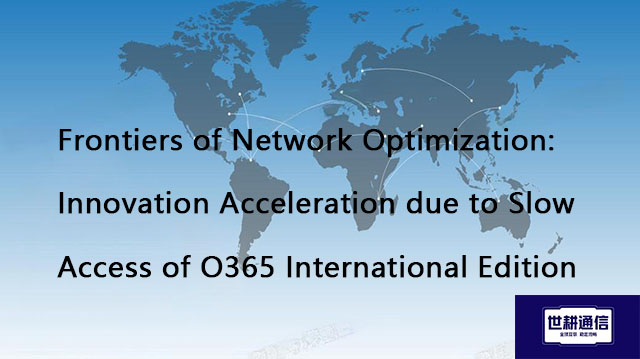Frontiers of Network Optimization: Innovation Acceleration due to Slow Access of O365 International Edition??? Solution//Global IPLC service provider of Shigeng Communication
一、In the context of global digital transformation, Microsoft Office 365 International has become a core tool for cross-border enterprise collaboration. However, Chinese users generally face pain points such as high latency, frequent packet loss, and unstable connections when accessing O365 services deployed overseas. According to actual test data, the latency of accessing Teams in a regular public network environment can reach 122ms, with a significant failure rate in TCP connection testing and a packet loss rate of 5% -10%, seriously hindering the efficiency of real-time meetings and file synchronization. The root of this problem lies in the superposition of three factors: physical distance limit of cross-border network transmission, Internet congestion and protocol interference. To address this challenge, the new generation of acceleration solutions is achieving breakthrough innovations in architecture optimization, protocol reconstruction, and intelligent scheduling.
1. Essence of the problem: in-depth analysis of performance bottlenecks in cross-border access
The experience dilemma of Office 365 International Edition in China mainly stems from inherent defects in its service architecture and network path:
Physical latency is unavoidable: Chinese users need to cross tens of thousands of kilometers to access European and American data centers. Even if the theoretical delay of light speed transmission exceeds 50ms, it often exceeds the 100ms threshold after adding route jumps;
Public network congestion intensifies and fluctuates: cross-border Internet nodes are congested during peak hours, resulting in a sharp increase in TCP retransmission rate and lack of QoS guarantee, especially audio and video conferences;
Protocol restrictions add insult to injury: Although traditional MPLS dedicated lines can improve stability, they suffer from deployment cycles of up to 3-6 months, high costs, and inability to adapt to the dynamic nature of cloud services.
2. Innovation Acceleration Solution 1: SD-WAN Driven Intelligent Routing Optimization
SD-WAN technology reconstructs the path selection mechanism for enterprise cloud services through software defined network architecture, becoming the mainstream solution for O365 acceleration:
Dynamic path selection: monitor the status of multiple links (such as the Internet, 4G/5G) in real time, and automatically switch the O365 traffic to a low latency, low packet loss channel. Actual testing shows that Teams call latency can be reduced from 122ms to 22ms, a decrease of 82%;
Deep optimization of protocol layer: Integrating TCP acceleration algorithms (such as forward error correction FEC, fast retransmission) to combat packet loss and reduce transmission load through data compression. In a certain case, this technology reduced the packet loss rate of 100 Ping tests from 4% to 0%;
Application level QoS guarantee: Identify critical application traffic such as Teams and SharePoint, prioritize bandwidth allocation, and limit non business traffic preemption. For example, automatically increasing the priority of UDP streams during video conferences to ensure smooth transmission of 1080p images.
Case verification: After a multinational manufacturing enterprise deployed SD-WAN, the loading time for Excel online collaboration was reduced from 15 seconds to 3 seconds, and the number of monthly meeting interruptions decreased by 90%.
3. Innovation Acceleration Plan 2: Architecture Revolution of Global Backbone Network and Edge POP Nodes
The traditional "user public network data center" direct connection model is being replaced by distributed edge access architecture:
Near Earth Access: Set up POP (Service Access Points) in first tier cities such as Beijing, Shanghai, Guangzhou, and Shenzhen, and first connect user traffic to local nodes with a delay of ≤ 10ms;
Backbone network tunnel transmission: By using a private high-speed tunnel protocol (such as Vecloud's UltraPath), traffic is transmitted transparently to overseas edge nodes to avoid public network congestion areas. This technology enables cross-border transmission delay fluctuations to be controlled within ± 5ms;
Microsoft Global Network Direct Connection: Establishing dedicated line connections in Microsoft data center hubs such as Frankfurt and Singapore, with a final hop latency of less than 2ms.
This solution compresses the end-to-end latency of servers from China to Europe from 180ms to 98ms, surpassing the technical specifications of MPLS dedicated lines.
4. Embedded QoS: Application aware bandwidth management technology
In response to the differences in traffic characteristics among different components of O365, the new generation of acceleration devices introduces a dynamic traffic profiling engine:
Real time classification engine
Identify Exchange traffic as burst sensitive and ensure upstream bandwidth
Mark Teams as delay sensitive and allocate dedicated virtual channels
Predictive bandwidth reservation:
Automatically reserve 15% bandwidth for Teams backup when detecting user initiated Outlook large attachment download to avoid meeting lag
Microsecond level scheduling:
Adopting DPDK accelerated traffic scheduler, processing latency ≤ 100 μ s, ensuring stable transmission interval of 4K video conference frames
conclusion
The access acceleration of Office 365 International has evolved from simple bandwidth expansion to a collaborative technology system that integrates SD-WAN intelligent scheduling, global private backbone network, and application aware QoS. With Vecloud and other vendors deploying over 300 POP nodes globally, and the successful validation of embedded QoS in large enterprises, Chinese enterprises now have the ability to obtain localized experience level access to O365 International Edition. In the future, with the deep integration of edge computing and protocol layer innovation, the "regional transparency" of transnational cloud service access will become the new normal of network architecture. For Fortune 500 companies or growth oriented enterprises, choosing an acceleration plan that adapts to their own business characteristics will be a key strategic investment to enhance global collaboration efficiency.

二、Shigeng Communication Global Office Network Products:
The global office network product of Shigeng Communication is a high-quality product developed by the company for Chinese and foreign enterprise customers to access the application data transmission internet of overseas enterprises by making full use of its own network coverage and network management advantages.
Features of Global Application Network Products for Multinational Enterprises:
1. Quickly access global Internet cloud platform resources
2. Stable and low latency global cloud based video conferencing
3. Convenient and fast use of Internet resource sharing cloud platform (OA/ERP/cloud storage and other applications
Product tariff:
Global office network expenses | Monthly rent payment/yuan | Annual payment/yuan | Remarks |
Quality Package 1 | 1000 | 10800 | Free testing experience for 7 days |
Quality Package 2 | 1500 | 14400 | Free testing experience for 7 days |
Dedicated line package | 2400 | 19200 | Free testing experience for 7 days |







